11-6 The dense atmosphere of Venus and the thin Martian atmosphere are dramatically different but have similar chemical compositions
On Venus, sulfuric acid rain evaporates before reaching the ground; on Mars, it snows frozen carbon dioxide
We have seen that the three large terrestrial planets—Earth, Venus, and Mars—display very different styles of geology. As we will discover, these differences help to explain why each of these three worlds has a distinctively different atmosphere.
To explore a planet’s atmosphere it is necessary to send a spacecraft to make measurements as it descends through that atmosphere. Both Soviet and U.S. spacecraft have done this for Venus (see Figure 11-23), and seven U.S. spacecraft have successfully landed on Mars. The results of these missions are summarized in Figure 11-24, which shows how pressure and temperature vary with altitude in the atmospheres of Earth, Venus, and Mars.
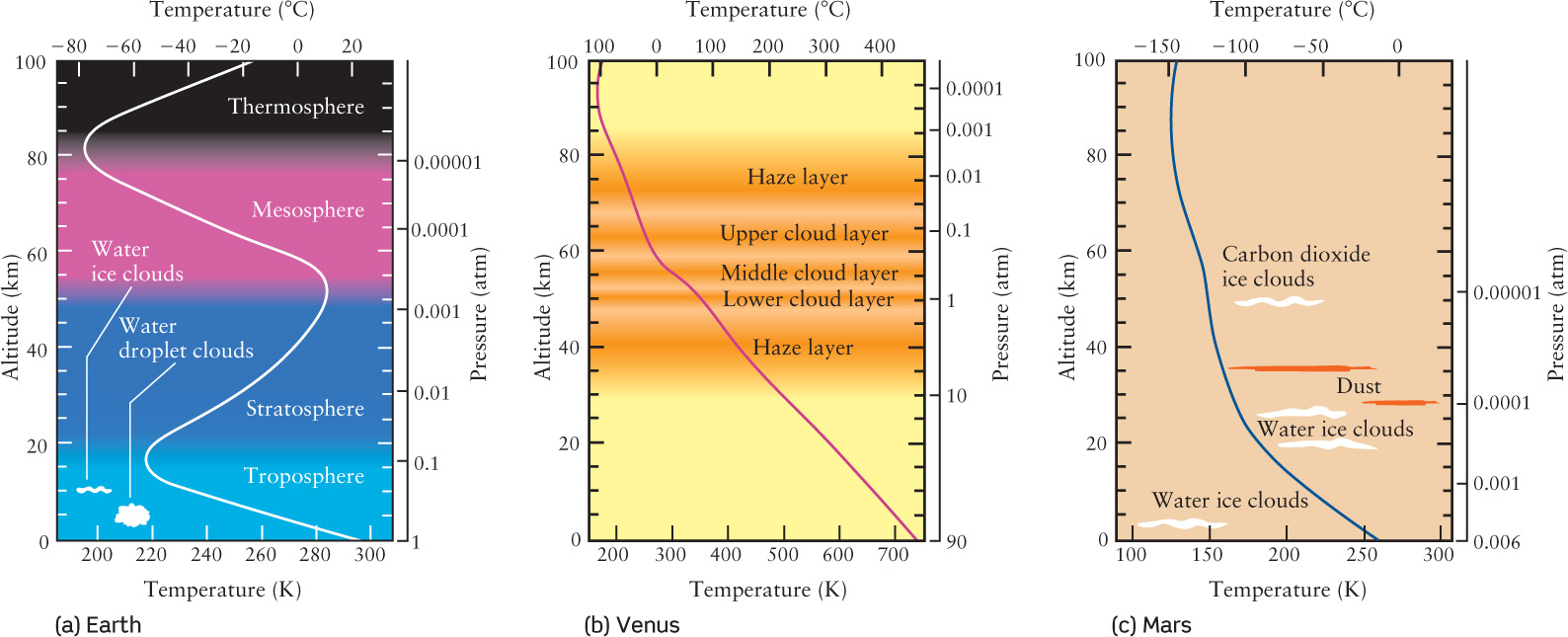
The Venusian Atmosphere: Dense, Hot, and Corrosive
Figure 11-24b depicts just how dense the Venusian atmosphere is. At the surface, the pressure is 90 atmospheres. This pressure is 90 times greater than the average air pressure at sea level on Earth and is about the same as the water pressure at a depth of about 1 kilometer below the surface of Earth’s oceans. The density of the atmosphere at the surface of Venus is likewise high, more than 50 times greater than the sea-level density of our atmosphere. The atmosphere is so massive that once heated by the Sun, it retains its heat throughout the long Venusian night. As a result, temperatures on the day and night sides of Venus are almost identical.
The composition of atmosphere explains why Venus’s surface temperatures are so high: 96.5% of the molecules in Venus’s atmosphere are carbon dioxide, with nitrogen (N2) making up most of the remaining 3.5% (see Table 9-4 for a comparison of the atmospheres of Venus, Earth, and Mars). Because Venus’s atmosphere is so thick, and because most of the atmosphere is the greenhouse gas CO2, the greenhouse effect (Section 9-1) has run wild. On Earth the greenhouse gases H2O and CO2 together make up only about 1% of our relatively sparse atmosphere, and the greenhouse effect has elevated the surface temperature by an additional 33°C (59°F). But on Venus, the dense shroud of CO2 traps infrared radiation from the surface so effectively that the surface temperature is more than 400°C (720°F) greater than it would have been without the CO2.
Soviet and U.S. spacecraft also discovered that Venus’s clouds are primarily confined to three high-altitude layers. An upper cloud layer lies at altitudes between 68 and 58 km, a denser and more opaque cloud layer from 58 to 52 km, and an even more dense and opaque layer between 52 and 48 km. Above and below the clouds are 20-km-thick layers of haze. Below the lowest haze layer, the atmosphere is remarkably clear all the way down to the surface of Venus.
We saw in Section 11-5 that sulfur, which is not found in any appreciable amount in our atmosphere, plays an important role in the Venusian atmosphere. Sulfur combines with other elements to form gases such as sulfur dioxide (SO2) and hydrogen sulfide (H2S), along with sulfuric acid (H2SO4), the same acid used in automobile batteries. While Earth’s clouds are composed of water droplets, Venusian clouds contain almost no water. Instead, they are composed of droplets of concentrated, corrosive sulfuric acid. Due to the high temperatures on Venus, these droplets never rain down on the planet’s surface; they simply evaporate at high altitude. (You can see a similar effect on Earth. On a hot day in the desert of the U.S. Southwest, streamers of rain called virga appear out of the bottoms of clouds but evaporate before reaching the ground.)
Convection in the Venusian Atmosphere
We saw in Section 9-6 that Earth’s atmosphere is in continuous motion: Hot gases rise and cooler gases sink, forming convection cells in the atmosphere. The same is true on Venus, but with some important differences. On Venus, gases in the equatorial regions are warmed by the Sun, then rise upward and travel in the upper cloud layer toward the cooler polar regions. At the polar latitudes, the cooled gases sink to the lower cloud layer, in which they are transported back toward the equator. The result is two huge convection cells, one in the northern hemisphere and another in the southern hemisphere (Figure 11-25a). These cells are almost entirely contained within the main cloud layers shown in Figure 11-24b. The circulation is so effective at transporting heat around Venus’s atmosphere that there is almost no temperature difference between the planet’s equator and its poles. By contrast, Earth’s atmosphere has a more complicated convection pattern (see Figure 11-25b and Figure 9-25) because Earth’s rotation—which is far more rapid than Venus’s—distorts the convection cells.
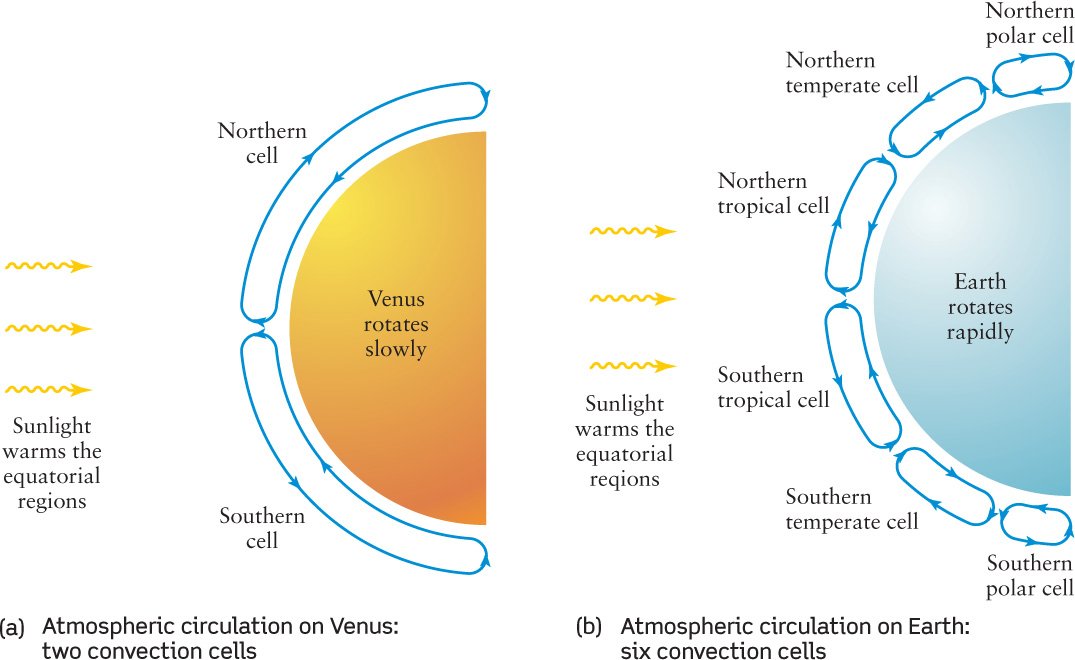
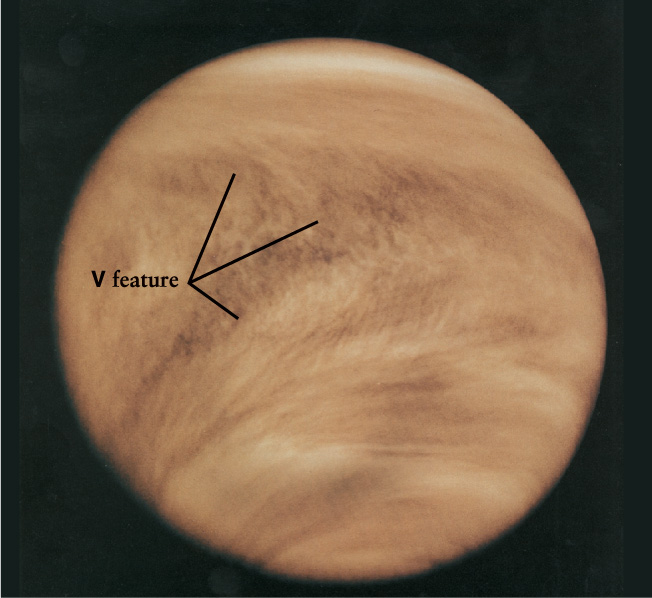
Venus’s Cloud Patterns This false-color image of Venus was made at ultraviolet wavelengths, at which the planet’s atmospheric markings stand out best. The dark V feature is produced by the rapid motion of clouds around the planet’s equator. The clouds move in the same retrograde direction as the rotation of the planet itself but at a much greater speed.
In addition to the north-south motions due to convection, high-altitude winds with speeds of 350 km/h (220 mi/h) blow from east to west, the same direction as Venus’s retrograde rotation. Thus, the upper atmosphere rotates around the planet once every 4 days. The fast-moving winds stretch out the convection cells and produce V-shaped, chevronlike patterns in the clouds (Figure 11-26). In a similar way, Earth’s rotation stretches out the convection cells in our atmosphere to produce the complicated circulation patterns shown in Figure 9-25.
On Earth, friction between the atmosphere and the ground causes wind speeds at the surface to be much lower than at high altitude. The same effect occurs on Venus: The greatest wind speed measured by spacecraft on Venus’s surface is only about 5 km/h (3 mi/h). Thus, only slight breezes disturb the crushing pressures and infernal temperatures found on Venus’s dry, lifeless surface.
The Martian Atmosphere: Not a Drop to Drink
As Figure 11-24c shows, the atmosphere of Mars is very cold and thin compared to the atmosphere of either Earth or Venus: The surface pressure is a mere 0.006 atmosphere. But its chemical composition is very close to that of Venus: The Martian atmosphere is 95.3% carbon dioxide (versus 96.5% for Venus) and 2.7% nitrogen (versus 3.5% for Venus). The predominance of carbon dioxide means that Mars, like Earth and Venus, is warmed by the greenhouse effect. However, the Martian atmosphere is so thin that the greenhouse effect is very weak and warms the Martian surface by only 5°C (versus 33°C on Earth). While the perpetual cloud cover on Venus maintains a steady surface temperature, the thin atmosphere on Mars provides very little thermal insulation. While daytime highs on Mars can be as high as 20°C (68°F), at night the temperature can plummet to -140°C (-220°F).
Water vapor makes up about 0.03% of the Martian atmosphere (versus about 1% for Earth), and this vapor can form clouds. Figure 11-21b shows clouds that form near the tops of Martian volcanoes when air moves up the volcanic slopes. The rising air cools until the water vapor condenses into ice crystals. The same process occurs on Earth, but the clouds that form in this way are made of droplets of liquid water rather than ice crystals. Why is there a difference?
The explanation is that liquid water cannot exist anywhere on the Martian surface or in the Martian atmosphere. Water is liquid over only a limited temperature range: If the temperature is too low, water becomes ice, and if the temperature is too high, it becomes water vapor. What determines this temperature range is the atmospheric pressure above a body of water or around a water drop. If the pressure is very low, molecules easily escape from the liquid’s surface, causing the water to vaporize. Thus, at low pressures, water more easily becomes water vapor. The average surface temperature on Mars is only about 250 K (-23°C, or -10°F), and the average pressure is only 0.006 atmosphere. With this combination of temperature and pressure, water can exist as a solid (ice) and as a gas (water vapor) but not as a liquid. (You can see this same situation inside a freezer, where water vapor swirls around over ice cubes.) Hence, it never rains on Mars and there are no bodies of standing water anywhere on the planet.
In order to keep water on Mars in the liquid state, it would be necessary to increase both the temperature (to keep water from freezing) and the pressure (to keep the liquid water from evaporating). Later in this chapter we will see evidence that higher temperatures and pressures did exist on Mars billions of years ago, and that there was once liquid water on the surface.
Methane in the Martian Atmosphere
The discovery of large quantities of methane (CH4) in the Martian atmosphere came as a big surprise in 2003. More specifically, while some methane is expected, the observed variation (over time, and for different regions) in the methane abundance is not understood. Because methane is destroyed in the Martian atmosphere after about 300 years, the discovery of large variations in methane abundance indicate an ongoing variable process for producing and removing methane. The source for more than 95% of Earth’s methane is well known: life! Naturally, these observations raise some hopes for a microbial source of the Martian methane, possibly varying with the seasons. Another proposed source is geologic activity (such as volcanism), which would imply significantly more ongoing geologic activity than observed on Mars so far. Either way, solving the methane mystery seemed to promise breakthroughs in either Martian biology or geology.
However, in 2012, scientists found evidence for a third scenario involving meteorites to explain Martian methane. Small micrometeorites have showered Mars for billions of years, and, unlike on Earth, these meteorites do not burn up in the thin Martian atmosphere. Also, compared to Earth, ultraviolet (UV) light on the Martian surface is more intense without absorption in an atmospheric ozone layer. Taken together, a large quantity of meteoritic material on Mars is exposed to intense UV light.
By exposing UV light to actual meteorites on Earth with a similar carbon composition to meteoritic material on Mars, scientists found that the UV exposure produces methane. Furthermore, the amount of methane produced depends on temperature and would vary with the Martian seasons and latitude. And, by exposing new surfaces, even the movement of small meteorites by dust storms would produce significant variations in methane production. These results do not disprove that biology or geology are contributing to methane production, but it weakens the case for these causes. Fortunately, instruments on the Mars rover Curiosity can detect methane and should help to determine its origins.
The Martian Poles: Freezing the Atmosphere
Figure 11-24c shows that at very high altitudes above the Martian surface, atmospheric carbon dioxide can freeze into crystals and form clouds. (Frozen carbon dioxide can be made on Earth and is called “dry ice.”) Such frozen carbon dioxide is also found in large quantities in ice caps at the north and south poles of Mars (Figure 11-27). Although no spacecraft has successfully landed on the ice caps, their composition can be measured from orbit by comparing the spectrum of sunlight reflected from the ice caps with the known reflection spectrum of frozen carbon dioxide. (Figure 7-4b shows another application of this idea.)
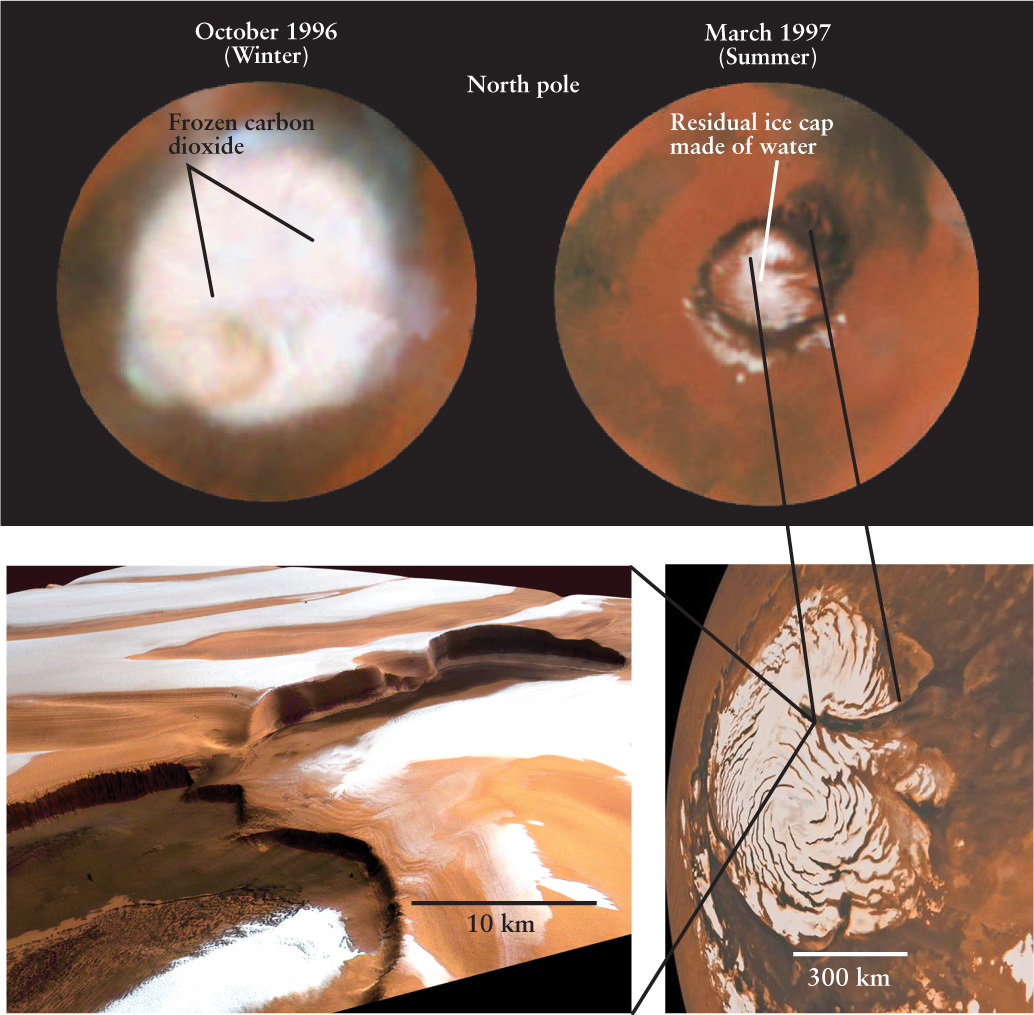
Changing Seasons Reveal Water-Ice at the Martian North Pole (a) During the Martian winter, the temperature drops so low that carbon dioxide freezes out of the Martian atmosphere to make a large polar ice cap of carbon dioxide. During summer, the carbon dioxide returns to the atmosphere, revealing a residual ice cap made of water. (b) The dark canyon, Chasma Boreale, is more than 300 km long—similar in length and depth to the Grand Canyon, Arizona. Spectra reveal the residual ice is made of water and not CO2.
As shown in Figure 11-27a, the size of the ice caps varies substantially with the seasons. When it is winter at one of the Martian poles, temperatures there are so low that atmospheric carbon dioxide freezes and the ice cap grows. (Think of it: It gets so cold at the Martian poles that the atmosphere freezes!) With the coming of warmer spring temperatures, much of the carbon dioxide returns to the gaseous state and the ice cap shrinks. With the arrival of summer, however, the rate of shrinkage slows abruptly and a residual ice cap remains solid throughout the summer. Scientists had long suspected that the north and south residual polar caps contain a large quantity of frozen water that is less easily evaporated (Figure 11-27b). The ESA’s Mars Express spacecraft confirmed this idea by detecting the characteristic spectrum of water ice.
The wintertime freezing of atmospheric carbon dioxide was observed by the Viking Lander 1 and Viking Lander 2 spacecraft, which made the first successful landings on Mars in 1976. Both of these spacecraft touched down in the northern hemisphere of Mars (you can see the landing sites in Figure 11-17). Figure 11-28 compares the springtime and wintertime views seen from the Viking Landers. Closer to the north pole, seasonal warming of carbon dioxide has lead to a very strange landscape (Figure 11-29). The dark areas in this image are dust patches that only become exposed after carbon dioxide ice evaporates off the surface. On the steeper slopes, the dust cascades down, creating the dark treelike streaks.

Seasons on the Martian Surface (a) This springtime view from Viking Lander 1 shows rocks that resemble volcanic rocks on Earth (see Figure 9-19a). They are thought to be part of an ancient lava flow that was broken apart by crater-forming asteroid impacts. Fine-grained debris has formed sand dunes. (b) This picture was taken during midwinter at the Viking Lander 2 site. Freezing carbon dioxide condenses onto water-ice crystals or dust grains in the atmosphere, causing them to fall to the ground and coat the surface with frost. This frost lasted for about a hundred days.
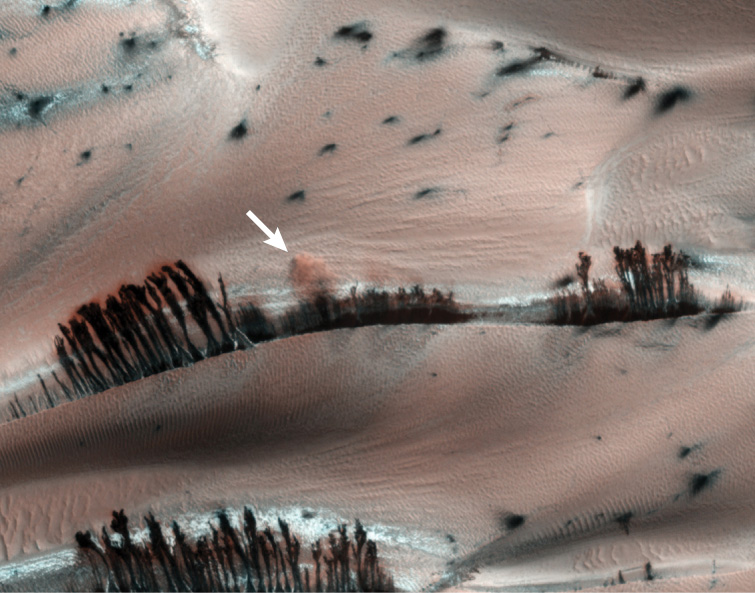
Spring on Mars The dark areas in this enhanced-color image are dust patches uncovered by evaporating carbon dioxide ice near the north pole in springtime. On the steeper slopes, the dust cascades down, creating the dark treelike streaks. The yellow arrow points to a plume being kicked up by one of these dust-slides.
Snowfall on Mars
Similar to the way that frost can form on a car’s windshield on a cold morning, water and carbon dioxide in the Martian atmosphere can form frost as in Figure 11-28b. However, actual snowfall from clouds indicates a more complex climate system that also occurs on Mars. In 2008, NASA’s Phoenix lander detected water-snow from clouds about 4 km above the lander. As the Martian winter approached and temperatures dropped, reflections from a green laser shot into the clouds above the lander revealed large ice crystals, large enough to assume they fell to the ground. The snow was assumed to be water-snow because it was not yet cold enough for carbon dioxide to freeze.
Then, in 2012, astronomers reported that Mars Reconnaissance Orbiter found evidence of falling snow made from carbon dioxide (CO2) during the deep cold of winter—the only known case of CO2 snowfall anywhere in our solar system. The snow was detected above the Martian south pole through its visible and infrared spectrum, and was observed extending all the way to the ground.
Martian Dust, Dunes, and Devils
Figure 11-28a shows that the landscape around the Viking Lander 1 is covered with a fine-grained dust. On much larger scales, wind can pile up the dust particles to form sand dunes (Figure 11-30). The dust particles are much smaller than ordinary household dust on Earth: They are only about 1μm (10−6 m) across, about the size of the particles in cigarette smoke.
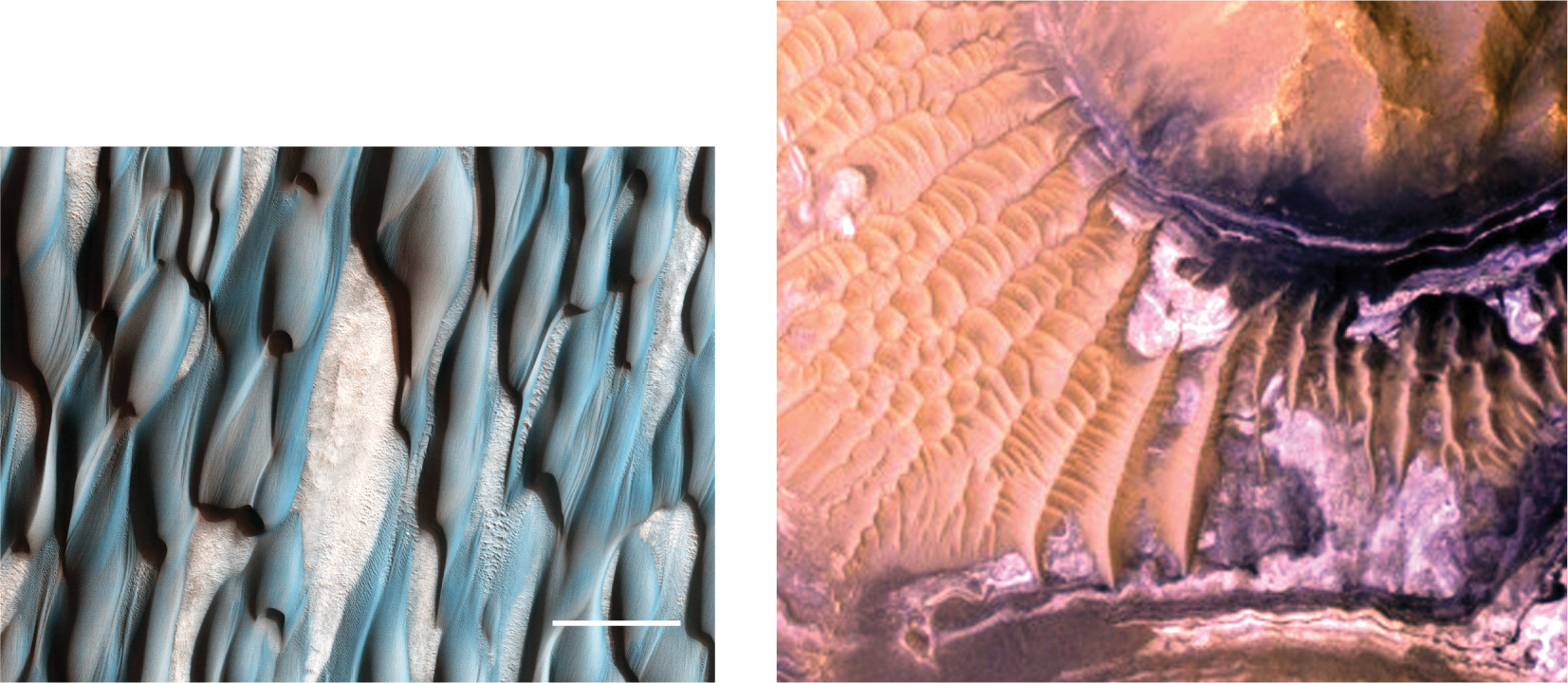
Martian Sand Dunes (a) Enhanced-coloring brings out the composition of these dunes. Blue indicates sand that came from volcanic rock. The lighter colors on top are probably very fine-grained dust. (b) Sand from clay minerals form dunes that partially cover sedimentary rock.
Because Martian dust is so fine, it can be carried aloft and spread over the surface by Martian winds even though the atmosphere is so tenuous. (A wind of 100 km/h, or 60 mi/h, on Mars is only about as strong as an Earth breeze of 10 km/h or 6 mi/h.) Windblown dust can sometimes be seen from Earth as a yellow haze that obscures Martian surface features. Figure 11-14 shows a dust storm that covered the entire planet, triggered by the flow of carbon dioxide evaporating from the north polar ice cap with the coming of northern spring. On Earth, stormy weather means cloudy skies, wind, and falling rain; on Mars, where no raindrop falls, stormy weather means wind and dust.
Dust also plays a role in the ordinary daily weather on Mars. Each afternoon, columns of warm air rise from the heated surface and form whirlwinds called dust devils (Figure 11-31). A similar phenomenon with the same name occurs in dry or desert terrain on Earth. Martian dust devils can reach an altitude of 6 km (20,000 ft) and help spread dust particles across the planet’s surface. Martian landers have measured changes in air pressure as dust devils swept past and sometimes several of these would pass in a single afternoon. As the sun sets and afternoon turns to evening, the dust devils subside until the following day.
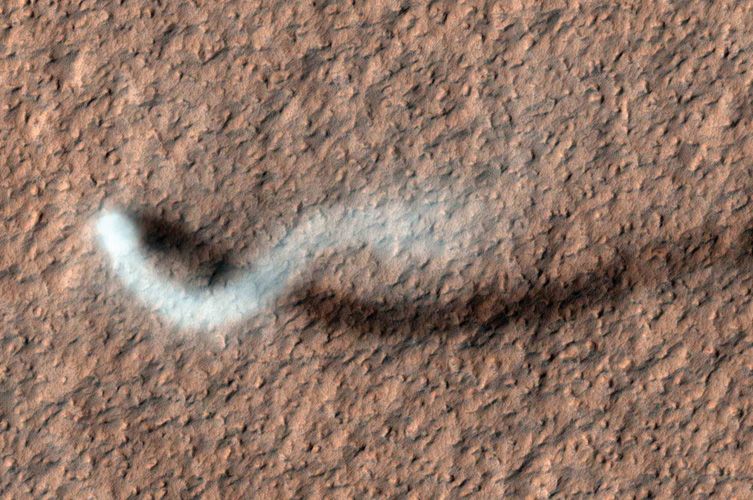
A Martian Dust Devil This Mars Global Surveyor image shows a dust devil as seen from almost directly above. This tower of swirling air and dust casts a long shadow in the afternoon sun. Spotted in 2012, this dust devil is about 100 feet wide and half a mile in height. About a month later, another dust devil was seen reaching a height of 12 miles!
CONCEPT CHECK 11-7
How might Mars’s environment become more hospitable to life if more CO2 could be added to the atmosphere?
If CO2 could be added to the atmosphere, the temperature on Mars might be increased through the greenhouse effect.
CONCEPT CHECK 11-8
What are three processes that could lead to variable amounts of methane on Mars?
Methane-producing microbes, volcanic activity, and the interaction of UV sunlight with small meteorites could all produce variable amounts of methane on Mars.